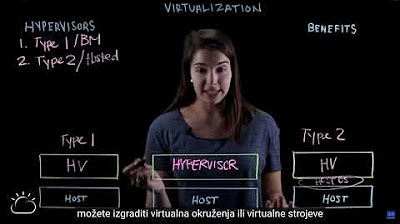Apa itu Virtualisasi ?
Summary
TLDRThis video explains the concept of virtualization in computing, where hypervisors allow a single machine to run multiple virtual machines (VMs). It covers the two types of hypervisors: Type 1 (bare-metal) and Type 2 (hosted), their uses, and how they enable resource allocation for running different operating systems and applications on one physical server. The video also highlights the benefits, such as cost savings, better hardware utilization, and disaster recovery, as well as challenges like licensing, security, and the need for skilled IT staff.
Takeaways
- 😀 Virtualization in computing is the simulation of physical hardware, software, operating systems, and networks using a hypervisor.
- 😀 There are two types of hypervisors: Type 1 (bare-metal), which is installed directly on hardware, and Type 2 (hosted), which runs on top of an existing operating system.
- 😀 Type 1 hypervisors are used in data centers, with examples like VMware ESXi, and they manage hardware resources to create virtual machines (VMs).
- 😀 Type 2 hypervisors are typically used on personal computers for testing or educational purposes, examples include VirtualBox and VMware Workstation.
- 😀 Virtualization allows multiple virtual machines to run on a single physical server, each with its own operating system and applications.
- 😀 By using virtualization, businesses can consolidate physical servers, reducing the need for multiple machines, thus saving costs on hardware and electricity.
- 😀 Virtualization improves management and portability, as virtual machines can easily be transferred to different physical machines if necessary.
- 😀 Virtualization helps maximize the utilization of hardware by running multiple VMs, each utilizing the full computational power of the host machine.
- 😀 Disaster recovery is more efficient with virtualization, as VMs can be backed up and migrated to other machines in case of hardware failure.
- 😀 Virtualization can introduce challenges such as licensing issues, security concerns, and the need for experienced IT staff to manage the system effectively.
- 😀 Virtualization is particularly beneficial for businesses that need to run different operating systems and applications on the same physical infrastructure.
Q & A
What is virtualization in computing?
-Virtualization in computing refers to the process of simulating hardware and software in a computer system. This allows one machine to run multiple virtual machines (VMs), each with its own operating system and applications.
What is a hypervisor?
-A hypervisor is software that creates and manages virtual machines by allocating resources like storage, RAM, and CPU. It runs on a physical machine and enables multiple virtual environments to coexist.
What are the two types of hypervisors?
-The two types of hypervisors are Type 1 and Type 2. Type 1 is installed directly on the physical hardware, while Type 2 is installed on top of an existing operating system.
Can you give examples of Type 1 hypervisors?
-Examples of Type 1 hypervisors include VMware ESXi, which is installed directly on the hardware without an underlying operating system.
What is the main difference between Type 1 and Type 2 hypervisors?
-The main difference is that Type 1 hypervisors run directly on the physical hardware, whereas Type 2 hypervisors run on top of an existing operating system, which serves as an intermediary.
Why is virtualization useful in business environments?
-Virtualization allows businesses to consolidate multiple physical servers into one, improving resource utilization, reducing hardware costs, and simplifying management and maintenance.
How does virtualization save businesses money?
-Virtualization reduces the need for multiple physical machines, cutting down on hardware expenses and energy consumption, which can lead to significant cost savings.
How can virtualization help in disaster recovery?
-Virtual machines (VMs) are just files that can be easily backed up, transferred, and restored on another physical server in the event of hardware failure, improving disaster recovery processes.
What are the potential drawbacks of virtualization?
-Some drawbacks include the need for software licensing, security concerns, and the requirement for skilled IT personnel to manage the virtualized environment effectively.
What is an example of how virtualization can be applied in a business scenario?
-A business could use virtualization to run three virtual machines on a single server: one for email services with Linux, another for a web server with Windows, and a third for a database with Unix, thus consolidating hardware and improving efficiency.
Outlines

このセクションは有料ユーザー限定です。 アクセスするには、アップグレードをお願いします。
今すぐアップグレードMindmap

このセクションは有料ユーザー限定です。 アクセスするには、アップグレードをお願いします。
今すぐアップグレードKeywords

このセクションは有料ユーザー限定です。 アクセスするには、アップグレードをお願いします。
今すぐアップグレードHighlights

このセクションは有料ユーザー限定です。 アクセスするには、アップグレードをお願いします。
今すぐアップグレードTranscripts

このセクションは有料ユーザー限定です。 アクセスするには、アップグレードをお願いします。
今すぐアップグレード5.0 / 5 (0 votes)






